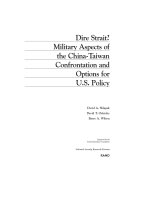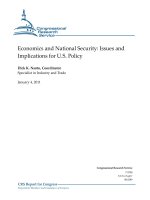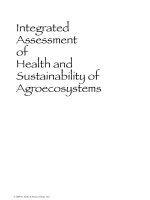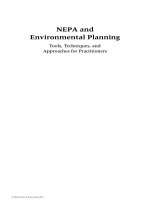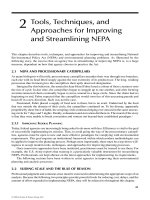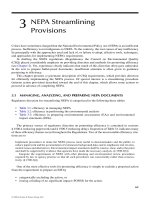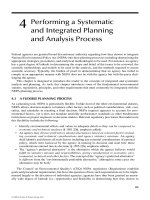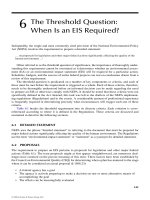NEPA and Environmental Planning : Tools, Techniques, and Approaches for Practitioners - Chapter 1 pptx
Bạn đang xem bản rút gọn của tài liệu. Xem và tải ngay bản đầy đủ của tài liệu tại đây (668.03 KB, 45 trang )
NEPA and
Environmental Planning
Tools, Techniques, and
Approaches for Practitioners
CRC_7559_FM.indd iCRC_7559_FM.indd i 1/31/2008 5:36:38 PM1/31/2008 5:36:38 PM
© 2008 by Taylor & Francis Group, LLC
NEPA and
Environmental Planning
Tools, Techniques, and
Approaches for Practitioners
Charles H. Eccleston
CRC_7559_FM.indd iiiCRC_7559_FM.indd iii 1/31/2008 5:36:38 PM1/31/2008 5:36:38 PM
© 2008 by Taylor & Francis Group, LLC
CRC Press
Taylor & Francis Group
6000 Broken Sound Parkway NW, Suite 300
Boca Raton, FL 33487-2742
© 2008 by Taylor & Francis Group, LLC
CRC Press is an imprint of Taylor & Francis Group, an Informa business
No claim to original U.S. Government works
Printed in the United States of America on acid-free paper
10 9 8 7 6 5 4 3 2 1
International Standard Book Number-13: 978-0-8493-7559-0 (Hardcover)
This book contains information obtained from authentic and highly regarded sources Reasonable efforts have been
made to publish reliable data and information, but the author and publisher cannot assume responsibility for the valid-
ity of all materials or the consequences of their use. The Authors and Publishers have attempted to trace the copyright
holders of all material reproduced in this publication and apologize to copyright holders if permission to publish in this
form has not been obtained. If any copyright material has not been acknowledged please write and let us know so we may
rectify in any future reprint
Except as permitted under U.S. Copyright Law, no part of this book may be reprinted, reproduced, transmitted, or uti-
lized in any form by any electronic, mechanical, or other means, now known or hereafter invented, including photocopy-
ing, microfilming, and recording, or in any information storage or retrieval system, without written permission from the
publishers.
For permission to photocopy or use material electronically from this work, please access www.copyright.com (http://
www.copyright.com/) or contact the Copyright Clearance Center, Inc. (CCC) 222 Rosewood Drive, Danvers, MA 01923,
978-750-8400. CCC is a not-for-profit organization that provides licenses and registration for a variety of users. For orga-
nizations that have been granted a photocopy license by the CCC, a separate system of payment has been arranged.
Trademark Notice: Product or corporate names may be trademarks or registered trademarks, and are used only for
identification and explanation without intent to infringe.
Visit the Taylor & Francis Web site at
and the CRC Press Web site at
CRC_7559_FM.indd ivCRC_7559_FM.indd iv 1/31/2008 5:36:39 PM1/31/2008 5:36:39 PM
© 2008 by Taylor & Francis Group, LLC
To Our Son, Justin
We trained hard, but every time we began to form up teams we
would be reorganized. I was to learn later in life that we tend
to meet any new situation by reorganizing; and a wonderful
method it can be for creating the illusion of progress while
producing confusion, inefciency, and demoralization.
Petronius Arbiter, 210
B.C.
CRC_7559_FM.indd vCRC_7559_FM.indd v 1/31/2008 5:36:39 PM1/31/2008 5:36:39 PM
© 2008 by Taylor & Francis Group, LLC
vii
Contents
Preface xxi
Acknowledgments xxv
Author xxvii
List of Acronyms xxix
Introduction xxxi
Chapter 1 Overview of the NEPA Process and Its Basic Requirements 1
1.1 Overview of the NEPA Planning Process 1
1.1.1 Three Levels of NEPA Compliance 2
1.1.2 Compliance with Other Laws 2
1.1.2.1 No “Grandfathering” 2
1.1.3 Adopting NEPA Implementation Procedures 2
1.1.4 Initiating NEPA 4
1.1.4.1 Identifying a Proposed Action 5
1.1.4.2 Supplemental EISs and the Smithsonian Solution 5
1.1.4.3 Reviewing Existing EAs 5
1.1.5 Categorical Exclusions 5
1.1.6 Environmental Assessments 5
1.1.6.1 Commonly Required Data 6
1.1.6.2 Comparison of the Size and Complexity of EAs versus EISs 6
1.1.7 Environmental Impact Statements 7
1.1.7.1 The EIS Process 7
1.1.7.2 Notice of Intent 7
1.1.7.3 The Draft and Final EIS Stage 8
1.1.7.4 Record of Decision, Monitoring, and Mitigation 9
1.2 Basic Concepts and Requirements 9
1.2.1 Complying to the “Fullest Extent Possible” 9
1.2.1.1 Calvert Cliffs 10
1.2.1.2 Conict in Statutory Authority 11
1.2.1.3 Conicts with Other Statutory Obligations 11
1.2.1.4 Is It Appropriate to Design an Action to Avoid NEPA? 11
1.2.2 When Must NEPA Be Initiated? 12
1.2.2.1 The Denition of a Proposal 13
1.2.3 When Must NEPA Be Completed? 13
1.2.4 Combining and Integrating Other Requirements 13
1.2.5 Actions Subject to NEPA 14
1.3 NEPA Litigation and Judicial Review 15
1.3.1 Statute of Limitations 15
1.3.2 Administrative Record and Judicial Review Standard 15
1.3.2.1 Arbitrary Capricious Standard 15
1.3.2.2 Recent Case Law Involving the “Hard Look” Standard 16
1.3.2.3 Institute for Environmental Conict Resolution 16
1.3.3 Procedural versus Substantive 17
1.3.3.1 Case Law 17
1.3.3.2 Robertson v. Methow 18
CRC_7559_FM.indd viiCRC_7559_FM.indd vii 1/31/2008 5:36:39 PM1/31/2008 5:36:39 PM
© 2008 by Taylor & Francis Group, LLC
viii Contents
1.4 Closing Thoughts 18
Problems 19
References 19
Chapter 2 Tools, Techniques, and Approaches for Improving and Streamlining NEPA 21
2.1 NEPA and Processionary Caterpillars 21
2.1.1 Improving Federal Planning 21
2.2 Sliding Scale and the Rule of Reason 21
2.2.1 The Sliding-Scale Approach 22
2.2.2 Rule of Reason 22
2.3 Streamlining an Agency’s NEPA Process 22
2.4 VE Improvement Process 23
2.4.1 Preliminary Review 23
2.4.2 Seven Phases 23
2.4.2.1 Phase 1: Information Phase 24
2.4.2.2 Phase 2: Functional Analysis Phase 24
2.4.2.3 Phase 3: Creativity Phase 24
2.4.2.4 Phase 4: Evaluation and Analysis Phase 24
2.4.2.5 Phase 5: Development Phase 24
2.4.2.6 Phase 6: Presentation Phase 24
2.4.2.7 Phase 7: Post Study/Implementation Phase 25
2.4.3 Using VE in Preparing an EIS 25
2.4.3.1 Comparison of VE with NEPA 25
2.5 Using VE in Determining the Preliminary Scope of an EIS 26
2.5.1 Assembling an IDT 26
2.5.2 Information Phase 28
2.5.3 Decision-Identication Phase 28
2.5.4 Underlying Need and Purpose: Denition 28
2.5.5 Enhancing Effectiveness of the EIS Process 29
2.5.6 Investigating the No-Action Alternative 29
2.5.7 Eliminating Issues from the Scope 30
2.5.8 Identifying Other Related Requirements 30
2.5.9 Finalizing the Prescoping Effort 30
2.6
2.6.1 NEPA Provides an Ideal Implementation Mechanism 31
2.6.2 NEPA Provides a Comprehensive Decision-Making Process 32
2.6.3 Process for Integrating NEPA and P2 32
2.6.3.1 Categorical Exclusions 34
2.6.3.2 Environmental Assessment Process 37
2.6.3.3 EIS Process 37
2.7 NEPA and ISO 14001 38
2.7.1 An ISO 14001 Consistent EMS 38
2.7.2 Why NEPA and ISO 14001 Complement Each Other 40
2.7.2.1 Policy and Plan 41
2.7.2.2 Procedural versus Substantive 42
2.7.2.3 Analytical Similarities 42
2.7.2.4 Life Cycle Analysis 43
2.7.2.5 Public Participation 43
2.7.2.6 Signicance 43
2.7.2.7 Integration of Environmental Requirements 43
CRC_7559_FM.indd viiiCRC_7559_FM.indd viii 1/31/2008 5:36:39 PM1/31/2008 5:36:39 PM
A Strategy for Efficiently Implementing a Pollution Prevention Program 30
© 2008 by Taylor & Francis Group, LLC
Contents ix
2.7.2.8 Integrating Pollution Prevention 43
2.7.2.9 Preventive and Corrective Action 44
2.7.2.10 Records and Documentation 44
2.7.2.11 Implementation, Training, Monitoring,
and Continuous Improvement 44
2.7.2.12 Internal Auditing 44
2.7.3 Strategy for Integrating an EMS with NEPA 44
2.7.3.1 Policy and Planning Phase 45
2.7.3.2 Analysis, Signicance, and Decision-Making 46
2.7.3.3 Implementation Phase 46
2.7.3.4 Monitoring and Enforcement Phase 46
2.8 An Integrated NEPA, AM, and EMS System 47
2.8.1 NEPA and AM 47
2.8.1.1 Requirements for Implementing AM 47
2.8.2 Potential Advantages 48
2.8.2.1 NEPA Documents 49
2.8.3 Using an EMS to Implement AM 50
2.8.3.1 An Integrated AM/EMS System 51
2.9
2.9.1 Dilemma 53
2.9.2 Criteria for Developing the Sufciency Test Tool 53
2.9.3 The Sufciency Test Tool 53
2.9.4 Applying the Sufciency Test Tool 53
2.9.4.1 Advantages and Limitations 55
2.10 A 10-Step Formula for Improving the NEPA Process 56
2.10.1 Recommendations 56
2.10.2 Additional Recommendations for Improving NEPA 58
Problems 59
References 60
Chapter 3 NEPA Streamlining Provisions 63
3.1 Managing, Analyzing, and Preparing NEPA Documents 63
3.1.1 Integrating NEPA with SEPAs and Other Processes 67
3.2.1 Using Scoping to Narrow the Analysis 67
3.2.2 Tiering 67
3.2.3 Incorporation by Reference 68
3.2.4 Adoption 68
3.2.5 Piggybacking 69
3.3 Limitations on Actions and Interim Actions 69
3.3.1 Eligibility for Status as an Interim Action 70
3.3.2 Two Categories of Interim Actions 70
3.3.2.1 Additional Limitations 70
3.3.3 Limitations on Project-Specic Action 71
3.3.4 Limitations on Programmatic Actions 71
3.3.4.1 Justied Independently of the Program 71
3.3.4.2 Accompanied by an Adequate EIS 71
3.3.4.3 Not Prejudice the Ultimate Decision 72
3.3.5 Actions That Are Not Generally Permissible 72
3.3.6 Awarding Contracts Prior to Completing NEPA 72
CRC_7559_FM.indd ixCRC_7559_FM.indd ix 1/31/2008 5:36:39 PM1/31/2008 5:36:39 PM
Determining When Analysis Contains Sufficient Detail 52
3.2 Specific Streamlining Methods 67
© 2008 by Taylor & Francis Group, LLC
x Contents
3.4 Agency Management and Operational Changes 72
3.4.1 Revising NEPA Implementation Procedures 73
3.4.2 Delegation 73
3.5 Statistics on the NEPA Process 73
3.5.1 NEPA Activity 73
3.5.2 NEPA Effectiveness 74
3.5.3 Completion Time and Delays 75
3.5.3.1 Reasons for Delays 75
3.5.3.2 Reducing Delays as a Result of Law Suits 76
3.5.3.3 EA Completion Time 76
3.5.3.4 EIS Completion Time 76
3.5.4 Document Length 76
3.5.4.1 Environmental Assessments 76
3.5.4.2 Environmental Impact Statements 77
3.5.4.3 Congressional Taskforce 77
3.5.4.4 Environmental Protection Agency Study 77
3.5.4.5 Exceptions 77
3.5.5 Cost 78
3.5.5.1 Department of Energy and Air Force 78
3.5.5.2 CEQ Environmental Assessment Study 78
3.5.6 Lawsuits 79
3.5.6.1 NEPA Documents Challenged 79
3.5.6.2 Causes for Action 79
3.5.6.3 Plaintiffs 80
3.5.6.4 Injunctions 80
Problems 80
References 81
Chapter 4 Performing a Systematic and Integrated Planning and Analysis Process 83
4.1 A Flexible Planning Process 83
4.2 Fostering Planning and Informed Decision-Making 84
4.2.1 Early and Open Process 85
4.2.2 Public Involvement 86
4.2.3 Determining the Scope 86
4.3 Systematic and Interdisciplinary Approach 86
4.3.1 Environmental Design Arts 87
4.4 Integrating Other Laws, Permits, and Orders 87
4.4.1 Environmental Quality Improvement Act of 1970 88
4.4.1.1 Executive Order for Protection and Enhancement
of Environmental Quality 88
4.4.2 Federal Land Policy Management Act 89
4.4.2.1 Policy, Authority, and Responsibility 89
4.4.3 Natural Resource Damage Assessment 90
4.4.3.1 Assessment 91
4.4.3.2 Contingent Valuation Method 91
4.4.4 Pollution Prevention Act 92
4.4.4.1 Provisions 93
4.4.4.2 Executive Order and the CEQ Guidance 93
4.4.5 Clean Air Act Conformity and NEPA 93
4.4.5.1 General Conformity 93
CRC_7559_FM.indd xCRC_7559_FM.indd x 1/31/2008 5:36:39 PM1/31/2008 5:36:39 PM
© 2008 by Taylor & Francis Group, LLC
Contents xi
4.4.5.2 Potential Problems with Nonconformance 94
4.4.5.3 EPA Issues 94
4.4.5.4 Documents on the Web 94
4.4.6 CO
2
and Global Warming Issues in NEPA Documents 95
4.4.7 Endangered Species Act 95
4.4.7.1 Administration and Purpose 96
4.4.7.2 Implementing Regulations 96
4.4.7.3 Categories of Species 96
4.4.7.4 Scope 97
4.4.7.5 Section 7: Consultation 97
4.4.7.6 Consultation 97
4.4.7.7 Biological Evaluation and Assessment 98
4.4.7.8 Section 9 98
4.4.7.9 Section 10 99
4.4.7.10 Invasive Species and Executive Order 13112 99
4.4.8 Section 404 of the Clean Water Act 99
4.4.8.1 Section 404 99
4.4.8.2 Typical Activities and Exemptions 100
4.4.8.3 Basic Requirements 100
4.4.8.4 Swampbuster 100
4.4.8.5 Types of Permits 100
4.4.8.6 Permit Limitations and Mitigation 100
4.4.8.7 The 404 Permitting Process 101
4.4.8.8 Public Notice 101
4.4.8.9 Comment Period and Public Hearing 101
4.4.8.10 Permit Evaluation and Statement of Finding 101
4.4.9 Floodplain and Wetlands Executive Orders 101
4.4.10 Coastal Zone Management 101
4.4.10.1 Coastal Zone Management Act
Consistency Regulations 102
4.4.10.2 Consistency Determination 102
4.4.10.3 NEPA and Project Planning 102
4.4.11 Wild and Scenic Rivers Act 102
4.4.11.1 Wild River Areas 103
4.4.11.2 Scenic River Areas 103
4.4.12 Fish and Wildlife Coordination Act 103
4.4.13 National Historic Preservation Act 103
4.4.13.1 State Historic Preservation Ofcer 104
4.4.13.2 National Register of Historic Places 104
4.4.13.3 Eligibility Criteria 104
4.4.13.4 Section 106 104
4.4.13.5 Section 106 Review Process 105
4.4.13.6 Consultation 105
4.4.13.7 Changes to Section 106 106
4.4.13.8 Archaeological Resource Protection Act 106
4.4.13.9 Archaeological and Historic Preservation Act 107
4.4.13.10 Indian Religious Freedom Act 107
4.4.13.11 Native American Graves Protection
and Repatriation Act 107
4.4.14 Farmland and Protection Policy Act 107
4.4.14.1 Prime Farmland 107
CRC_7559_FM.indd xiCRC_7559_FM.indd xi 1/31/2008 5:36:39 PM1/31/2008 5:36:39 PM
© 2008 by Taylor & Francis Group, LLC
xii Contents
4.4.14.2 Unique Farmland 107
4.4.14.3 Integration with NEPA 107
4.4.15 Environmental Justice 107
4.4.15.1 Executive Order 108
4.4.15.2 CEQ Guidance 108
4.4.15.3 Analysis 108
4.5 Environmental Impact Assessment 109
4.5.1 Actions 109
4.5.2 Environmental Disturbances 110
4.5.3 Receptors and Resources 110
4.5.4 Impact Analysis 110
4.5.5 Signicance 111
4.5.6 Mitigation and Monitoring 111
4.5.6.1 Monitoring 112
4.5.7 Impact Assessment Methodologies 112
4.5.7.1 Environmental Checklists 112
4.5.7.2 Matrices 113
4.5.7.3 Networks 115
4.5.7.4 Carrying Capacity Analysis 116
4.5.7.5 Ecosystem Analyses 117
4.5.7.6 Cost–Benet Analysis 118
4.6 Requirements for Performing an Analysis 121
4.6.1 Performing a Rigorous Analysis 121
4.6.2 Methodology 122
4.6.3 Fair and Objective 122
4.6.4 Investigating Reasonable Alternatives 122
4.6.4.1 “Would” versus “Will” 122
4.6.5 Writing Documents in Plain English 124
4.6.5.1 Reasonable Man Standard 124
4.6.6 Incomplete or Unavailable Information 124
4.6.6.1 Classied Information 125
4.6.6.2 Case Law 125
Problems 125
References 126
Chapter 5 Exemptions and Categorical Exclusions 129
5.1 Categorical Exclusions 129
5.1.1 Extraordinary Circumstances 130
5.1.2 Adopting CATXs 130
5.1.3 Applying CATXs 131
5.1.4 Documenting CATXs 132
5.1.5 Streamlining Recommendations 132
5.1.5.1 Electronic CATX Management Database 132
5.1.5.2 Additional Recommendations 134
5.2 Exemptions from NEPA 134
5.2.1 Presidential Exemptions 136
5.2.2 Explicit Congressional Exemptions 136
5.2.3 Functional Equivalency Exemptions 137
5.2.4 The EPA 137
CRC_7559_FM.indd xiiCRC_7559_FM.indd xii 1/31/2008 5:36:40 PM1/31/2008 5:36:40 PM
© 2008 by Taylor & Francis Group, LLC
Contents xiii
5.2.5 Functional Equivalence with CERCLA 138
5.2.6 Functional Equivalence with RCRA 138
5.2.7 Implicit Statutory Conicts 139
5.2.7.1 Ministerial 139
5.2.8 Emergency Situations 140
5.2.8.1 CEQ Guidance 140
5.2.8.2 Examples of Past Emergencies 141
Problems 142
References 142
Chapter 6 The Threshold Question: When Is an EIS Required? 145
6.1 Detailed Statement 145
6.2 Proposals 145
6.3 Legislation 146
6.4 The Term “Major” 146
6.5 The Term “Federal Agency” 147
6.5.1 Factors That May Federalize an Action 147
6.5.1.1 Federal Support by Contract, Grant, Loan,
or Financial Assistance 148
6.5.1.2 Enablement by Permit, Lease, License, or Entitlement 148
6.5.1.3 Federal Control 149
6.5.1.4 Continuing Agency Involvement That
6.5.1.5 Causation 149
6.5.2 Basis for a General-Purpose Tool 149
6.5.3 General-Purpose Tool for Determining When Nonfederal
Actions Become Federalized 149
6.5.3.1 Using the Tool 151
6.6 Actions 151
6.6.1 Inaction 152
6.6.2 Applicability of NEPA to International Actions 152
6.6.2.1 Executive Order 152
6.6.2.2 Transboundary Effects 152
6.6.2.3 Case Law 153
6.7.1
6.7.2.1 Context 157
6.7.2.2 Intensity 157
6.8 Affecting 162
6.9 Human Environment 162
6.9.1 The Physical Environment 162
6.9.2 Impact and Effect 163
6.9.3 Environmental Impacts That Do Not Have to Be Considered 163
Problems 164
References 165
CRC_7559_FM.indd xiiiCRC_7559_FM.indd xiii 1/31/2008 5:36:40 PM1/31/2008 5:36:40 PM
Is Modified or Terminated 149
6.7 Significance 156
The Role of the Courts in Determining Significance 156
6.7.2 Regulatory Definition 157
6.7.2.3 Significant Departure 160
6.7.3 Significance and the National Historic Preservation Act 161
6.7.4 Determining a Significance Baseline 161
© 2008 by Taylor & Francis Group, LLC
xiv Contents
Chapter 7 Preparing Environmental Assessments 167
7.1 Overview 167
7.1.1 The Purpose of an EA 167
7.1.2 Comparison of EAs to EISs 168
7.1.3 Time Periods 169
7.2 Preparing and Issuing the Assessment 169
7.2.1 Public Involvement 169
7.2.1.1 Public Notication 169
7.2.1.2 The Public Review Process 171
7.2.1.3 Consultation 171
7.2.1.4 Case Law 171
7.2.2 Performing the Analysis 171
7.2.2.1 The Proposed Action 172
7.2.2.2 Reserving Signicance Findings
for the FONSI 172
7.2.3 Addressing Cumulative Impacts in EAs 172
7.2.3.1 Cumulative Impact Study 172
7.2.4 The Cilix Method 173
7.2.4.1 Standard Approach 173
7.2.4.2 Cilix Methodology 173
7.2.4.3 Restrictions 174
7.2.4.4 Application Scenarios 174
7.2.4.5 Advantages 175
7.2.4.6 Example 175
7.2.4.7 Justication 177
7.3 Issuing a FONSI 177
7.3.1 Waiting Period 177
7.4 The EA Documentation Requirements 177
7.4.1 Page Limitations 178
7.4.2 Requirements 178
7.4.2.1 Need for the Proposal 178
7.4.2.2 Proposed Action and Alternatives 178
7.4.2.3 Environmental Impacts of the Proposed
Action and Alternatives 179
7.4.2.4 Agencies and Persons Consulted 179
7.4.3 Suggested Outline 179
7.4.3.1 Suggested Outline for Section on Alternatives 180
7.4.3.2 Pollution Prevention 180
7.5 The FONSI 180
7.5.1 Documentation Requirements for FONSIs 181
7.5.1.1 EA Checklist Format 182
7.5.1.2 Judicial Review of EAs and FONSIs 182
7.6 Mitigation 183
7.6.1 Types of Mitigation 183
7.6.2 Advantages and Disadvantages 183
7.6.3 Analyzing the Effectiveness of Mitigation Measures 184
7.6.4 Legal Criteria for Mitigation 184
7.7 Streamlining the EA Process 184
7.7.1 Reducing Duplication and Delays 185
CRC_7559_FM.indd xivCRC_7559_FM.indd xiv 1/31/2008 5:36:40 PM1/31/2008 5:36:40 PM
© 2008 by Taylor & Francis Group, LLC
Contents xv
7.7.2 Tiering 185
7.7.3 Reducing the Length of Assessments 185
Problems 185
References 186
Chapter 8 Preparing Environmental Impact Statements 189
8.1 Overview of Fundamental EIS Concepts 189
8.1.1 Lead and Cooperating Agencies 189
8.1.1.1 Disputes 189
8.1.2 Selecting the Lead Agency 190
8.1.2.1 Lead Agency Responsibilities 190
8.1.2.2 Applicants 191
8.1.3 Schedule and Timing Requirements 191
8.1.3.1 When Should an EIS Begin? 192
8.1.3.2 How Long Should an EIS Take? 192
8.1.3.3 What Is the Maximum Page Limit for an EIS? 193
8.1.4 EIS Contractors 194
8.1.4.1 EIS Contractors and Conicts of Interest 194
8.1.5 Integrating Other Environmental Requirements 195
8.1.5.1 Pollution Prevention 195
8.1.6 National Register of Historic Places 195
8.1.6.1 Endangered Species 196
8.1.6.2 Floodplain and Wetlands Requirements 196
8.1.7 Classied Proposals, Emergency Situations, and Periodic Reviews 196
8.1.7.1 Classied Proposals 197
8.1.7.2 Emergency Situations 197
8.1.7.3 Guidance on Periodically Reexamining EISs 197
8.2 Preparing the EIS 197
8.2.1 Notice of Intent 197
8.2.1.1 Federal Register 198
8.2.2 The Scoping Process 198
8.2.2.1 Purpose of Scoping 199
8.2.2.2 Initiating the Scoping Process 199
8.2.2.3 Performing the Scoping Process 200
8.2.3 Decision-Based Scoping and Decision-Identication Tree 200
8.2.3.1 Decision-Based Scoping 200
8.2.3.2 Constructing the DIT 201
8.2.4 Preparing the Draft EIS 203
8.2.4.1 Issuing the Notice of Availability and the EPA Filing Process 204
8.2.4.2 Publication of the Notice in the Federal Register 204
8.2.4.3 EPA EIS Repository 205
8.2.4.4 Circulating the Draft EIS 206
8.2.4.5 Circulating a Summary 206
8.2.5 EPA Review under Section 309 of the CAA 207
8.2.5.1 EPA Review Responsibilities 207
8.2.5.2 EPA’s Rating of the Draft EIS 208
8.2.6 Scope of Draft EPA Comments 209
8.2.6.1 EPA Review of the Final EIS 210
CRC_7559_FM.indd xvCRC_7559_FM.indd xv 1/31/2008 5:36:40 PM1/31/2008 5:36:40 PM
© 2008 by Taylor & Francis Group, LLC
xvi Contents
8.2.6.2 EPA Monitoring and Follow-Up 210
8.2.6.3 Inviting Comments on the Draft EIS 210
8.2.7 Preparing the Final EIS 211
8.2.7.1 Issuing the Final EIS 212
8.2.7.2 Procedures for Issuing the Final EIS 212
8.2.7.3 Mandatory 30-Day Waiting Period 212
8.2.7.4 Exceptions 212
8.3 The ROD 213
8.3.1 Issuing the ROD 213
8.3.1.1 Selecting a Course of Action 213
8.4 Referrals 213
8.4.1 Procedure for Referrals 213
8.4.2 The Referral Process in Reality 214
8.5 Post EIS Monitoring and Enforcement 215
8.6 Legislative EISs 215
8.6.1 Preparing a Legislative EIS 215
8.7 Supplemental EIS 216
8.7.1 Requirements Governing S-EISs 216
8.7.1.1 Additional Direction 216
8.7.1.2 Reviewing the Agency’s Decision 217
8.7.2 Tiering and Supplementing EISs 217
8.7.3 Smithsonian Solution: Determining When a Change
Triggers Additional NEPA 217
8.7.3.1 Procedural Mechanisms Have Not Eliminated
the Potomac Paradox 218
8.7.3.2 Rationale for a Defensible Tool 218
8.7.3.3 Criteria for Assessing Changes 218
8.7.3.4 Smithsonian Solution Tool 219
8.8 Programmatic EISs 221
8.8.1 Example of a Recent P-EIS 221
8.8.2 Tiering and P-EISs 221
8.8.3 Cumulative Impact Scoping Dilemma 222
8.8.3.1 High-Level versus Low-Level Scoping 222
8.8.3.2 Dilemma 222
8.8.3.3 Resolving the Dilemma 223
8.8.4 Determining the Appropriate Scope of a P-EIS 223
8.8.4.1 The Basis for a Scoping Tool 223
8.8.4.2 A Tool for Determining Programmatic Scope 224
8.8.5 Case Law 226
8.8.5.1 Programs 226
8.8.5.2 Programmatic Alternatives 226
8.8.6 Strategic EAs 226
8.9 Streamlining the Review Process 227
Problems 227
References 228
Chapter 9 The Scope of Analysis 231
9.1 De-Emphasizing the Scope of Analysis 231
9.2 Managing Public Scoping Meetings 231
9.3 Actions, Alternatives, and Effects 231
CRC_7559_FM.indd xviCRC_7559_FM.indd xvi 1/31/2008 5:36:40 PM1/31/2008 5:36:40 PM
© 2008 by Taylor & Francis Group, LLC
Contents xvii
9.4 Three Types of Actions 232
9.4.1 Connected Actions 232
9.4.2 Cumulative Actions 233
9.4.2.1 Cumulative Actions versus Cumulative Impacts 233
9.4.3 Similar Actions 234
9.4.4 Categories of Federal Actions 234
9.4.4.1 Policies 234
9.4.4.2 Plans 234
9.4.4.3 Programs 234
9.4.4.4 Projects 235
9.4.5 Segmentation 235
9.4.5.1 Case Law 235
9.5 Three Types of Alternatives 235
9.5.1 No-Action Alternative 236
9.5.1.1 The No-Action Alternative versus
the Affected Environment 236
9.5.1.2 Describing the No-Action Alternative 236
9.5.2 Reasonable Alternatives 237
9.5.2.1 Dismissing Unreasonable Alternatives 238
9.5.2.2 Alternatives beyond an Agency’s Control 238
9.5.2.3 Court Direction on Preparing Alternatives 238
9.5.2.4 Dening a Range of Reasonable Alternatives 239
9.5.2.5 Describing Alternatives 239
9.5.2.6 Evaluating Hypothetical Scenarios 239
9.5.3 Mitigation Measures 240
9.6 Three Types of Impacts 240
9.6.1 Direct Impacts 240
9.6.2 Indirect Impacts 240
9.6.3 Cumulative Impacts 240
9.6.3.1 Innocuous Activities Have Cumulatively
Signicant Impacts 241
9.6.3.2 Dening Spatial and Temporal Bounds 241
9.6.3.3 Assessing Cumulative Effects 243
9.6.3.4 Litigation and Judicial Review 245
9.6.3.5 Court Direction on Performing CIA 246
9.6.4 Resolving Eccleston’s Cumulative Impact Paradox 246
9.6.4.1 The Paradox 247
9.6.4.2 Why It Is Important to Resolve This Paradox 248
9.6.4.3 Interpreting Signicance 248
9.6.4.4 Signicant Departure Principle 249
9.7 Special Impact Issues 255
9.7.1 Adequacy of the Analysis 255
9.7.2 Socioeconomic Impacts 255
9.7.2.1 Analysis of Socioeconomic Impacts 256
9.7.3 Short-Term versus Long-Term Impact 256
9.7.4 Bounding Analysis 256
9.7.5 Are Accident Scenarios Subject to NEPA’s Requirements? 256
9.7.5.1 Accident Analyses and Case Law 257
9.7.5.2 Sliding-Scale Approach 257
Problems 258
References 258
CRC_7559_FM.indd xviiCRC_7559_FM.indd xvii 1/31/2008 5:36:40 PM1/31/2008 5:36:40 PM
© 2008 by Taylor & Francis Group, LLC
xviii Contents
Chapter 10 Planning and Mitigating Effects of Natural
Disasters and Terrorist Attacks 261
10.1 Can Planning for a Disaster Prevent a Disaster? 261
10.1.1 Catastrophic Events and the Human Environment 261
10.1.2 Signicance 262
10.2 NRC Rules Terrorism Reviews Are Not Required 262
10.2.1 Nuclear Fuel Storage Case 262
10.2.1.1 Basis for NRC’s Conclusion 264
10.2.1.2 Court Rejects Reasoning 265
10.2.2 DOE Practice 265
10.2.2.1 DOE Litigation 266
10.3 Why NEPA Can Provide an Ideal Framework for Evaluating Terrorist
and Natural Disaster Scenarios? 266
10.4 Using NEPA to Plan for Potential Terrorist Acts and Natural Disasters 266
10.4.1 Strategic and Programmatic Reviews 266
10.4.2 Project-Specic Reviews 267
10.4.2.1 Environmental Impact Statements 267
10.4.2.2 Environmental Assessments 268
10.4.2.3 Categorical Exclusions 268
10.5 Differences between the Use of an EA and an EIS 269
10.5.1 Maximum Reasonably Foreseeable Events 269
10.5.1.1 Bounding 269
10.5.2 An EA versus an EIS Analysis 269
10.6 Analytical Methodology 270
10.6.1 Evaluating Potential Threats 270
10.6.1.1 Accident Analyses 271
10.6.2 Determining a Reasonable Range of Scenarios 271
10.6.3 Signicance and Potentially Catastrophic Scenarios 272
10.6.3.1 Decision-Making Criteria 272
10.6.4 Risk–Uncertainty Signicance Test 273
10.6.4.1 Uncertainty 273
10.6.4.2 Risk 274
10.6.4.3 Frequency 274
10.6.4.4 Severity 275
10.6.4.5 Assessing Signicance of a Potential Event 275
10.6.5 Modications to the Approach 276
10.7 A Tool for Determining If an Accident, Natural Disaster,
or Terrorist Event Should Be Evaluated 276
Problems 278
References 278
Chapter 11 Emergency Planning for Continuity of Business Operations 279
11.1.1 Developing the Business Continuity Plan 280
11.1.2 Business Risk 280
11.1.3 Benets of Business Continuity 280
11.2 Focusing on Continuity of Operations 282
11.2.1 Getting Started 282
11.2.2 Planning and Communicating the Program 282
CRC_7559_FM.indd xviiiCRC_7559_FM.indd xviii 1/31/2008 5:36:40 PM1/31/2008 5:36:40 PM
11.1 Essential Concepts and Benefits 280
© 2008 by Taylor & Francis Group, LLC
Contents xix
11.2.3 Gathering Information 283
11.2.3.1 Inventory of Essential Elements 284
11.2.4 Risk Assessment 285
11.3 Business Impact Analysis 285
11.3.1 Regulatory, Legal, and Contractual Review 286
11.3.1.1 Legal Risk Management Strategy 286
11.3.1.2 Potential Recommendations 287
11.3.2 Assessing and Analyzing Risks 287
11.3.2.1 Severity and Probability 287
11.3.2.2 Developing a BIA Process 288
11.4 Mitigation Strategies 289
11.4.1 Executive Decision-Making 289
11.4.2 Mitigation Implementation Plan 290
11.4.2.1 Plan Outline 290
11.4.2.2 Mitigation Budget 290
11.4.3 Potential Fixes 290
11.5 Implementing and Testing Preventive Measures 291
11.5.1 Testing and Action Plans 291
11.5.2 Quality Assurance 292
11.5.3 Training 292
11.6 Developing Contingency Plans 293
11.6.1 Contingency Planning Goals 293
11.6.2 Contingency Planning Factors 293
11.6.3 Potential Solutions 293
11.6.4 Types of Contingency Plans 294
11.6.5 Stafng Resources 294
11.6.6 Writing the Plan 294
11.6.7 Auditing and Testing 295
11.6.8 Management Approval 295
11.7 Monitoring Results: A Recap 295
11.7.1 Response and Resumption Resources 296
11.7.1.1 Critical Stafng Resources 296
11.7.2 Writing Procedures 296
11.7.3 Auditing the Documentation Process 296
Problem 297
References 297
Chapter 12 International Environmental Impact Assessment 299
12.1 NEPA and the International Community 299
12.1.1 Status of EIA Legislation in Developing Countries 299
12.1.2 International Organizations 300
12.1.2.1 United Nations 300
12.1.2.2 World Bank 300
12.1.2.3 European Union 301
12.1.2.4 NAFTA and Executive Order 13141 301
12.2 Fostering International Democracy 301
12.3 Introduction to the EIA Process 302
12.3.1 Typical EIA Process 302
12.3.2 EIA Document Content 304
CRC_7559_FM.indd xixCRC_7559_FM.indd xix 1/31/2008 5:36:41 PM1/31/2008 5:36:41 PM
© 2008 by Taylor & Francis Group, LLC
xx Contents
12.3.3 EIA Problems and Limitations 304
12.4 Introduction to SEA 305
12.4.1 Goals of SEA 306
12.4.1.1 Performance Criteria 306
12.4.2 Relationship between SEA and EIA 306
12.4.2.1 Comparison of SEA and EIA 307
Problems 308
References 308
Chapter 13 Environmental Policy, Decision-Making, and Economics 311
13.1 Easter Island and the Tragedy of the Commons 311
13.1.1 Tragedy of the Commons 312
13.2 Limits to Growth, Gaia, and Sustainability 313
13.2.1 Malthus, Simon, and Limits to Growth 313
13.2.1.1 The Malthusian Growth Model 314
13.2.1.2 Julian Simon 315
13.2.2 The Gaia Hypothesis 316
13.2.3 Sustainability 318
13.2.3.1 Denitions 318
13.2.3.2 Agenda 21 318
13.2.3.3 Sustainable Development, NEPA, and EPA 320
13.2.3.4 Business and Dow Jones Concepts of Sustainability 320
13.2.3.5 Adoption of Sustainability Policies 320
13.2.3.6 Basic Requirements 321
13.3 Methodologies for Dealing with Policy and Uncertainty 321
13.3.1 Precautionary Principle 322
13.3.2 Cost–Benet Analysis 323
13.3.3 Robust Planning and Assessment 323
13.4 Environmental Decision-Making 324
13.4.1 Ellsberg Paradox 324
13.4.1.1 NEPA and Environmental Decision-Making 325
13.4.1.2 Dealing with Uncertainty in NEPA Documents 325
13.4.2 Decision-Making and the Delphi Method 325
13.4.2.1 The Process 326
13.4.2.2 Advantages and Disadvantages 326
13.4.2.3 NEPA and Environmental Policy 326
13.5 Environmental Economics 326
13.5.1 Cost–Benet Analysis 327
13.5.2 Economic Surplus 327
Problems 327
References 327
Glossary 329
Appendix A 335
Appendix B 343
CRC_7559_FM.indd xxCRC_7559_FM.indd xx 1/31/2008 5:36:41 PM1/31/2008 5:36:41 PM
12.3.4 Disadvantages of Project-Specific EIAs 305
© 2008 by Taylor & Francis Group, LLC
xxi
Preface
From one perspective NEPA may be seen as the capstone of national environmental policy; more
importantly, it should be viewed as the foundation for the future.
Lynton Caldwell Congressional Testimony, 1998
National Environmental Policy Act (NEPA) analyses are frequently prepared that examine every
conceivable impact, signicant or otherwise, in excruciating detail, yet blatantly ignore the most
basic regulatory requirements regarding planning, decision-making, and efciency. Such practice
can lead to increased costs and delays and sometimes even to poorly planned projects. This book is
not about preparing bigger analyses; it is about producing better ones.
This book integrates three separate but interrelated themes into a single comprehensive frame-
work: (1) environmental planning procedures and practices, (2) NEPA, and (3) emergency response
planning. As a special feature, this book provides the reader with the rst comprehensive approach
using a NEPA (or a NEPA-like) process for identifying potential natural or human-induced threats
and evaluating potential consequences and alternatives; its intention is to help planners and
decision-makers in preparing for and mitigating the worst effects of potential terrorist attacks, nat-
ural disasters, and other emergencies. The processes described in these chapters have widespread
implications for the ways civilian agencies, communities, and the corporate world plan and prepare
to mitigate the impacts of such threats.
OBJECTIVES OF THIS BOOK
Emphasis is placed on addressing problems and dilemmas that have traditionally hindered NEPA
and other environmental planning. This book is unique in that it focuses on providing practitioners
and decision-makers with state-of-the-art tools, techniques, and approaches for resolving the fol-
lowing 10 elemental problems (Top 10 Problems) encountered in environmental impact assessment
and decision-making:
Sufciency Test—A defensible and systematic tool for determining how much information
and description are necessary or sufcient to adequately describe a topic, action, or impact
in a NEPA document (Section 2.9).
Smithsonian Solution—A defensible and streamlined tool for determining to what extent a
project can be changed (new circumstances or information) before that change triggers the
need for new or supplemental NEPA documentation (Section 8.7).
Action-Impact Model—There is a great diversity in both the quality and methodologies used
to assess the environmental consequences of a proposal. In professional practice, the spectrum
ranges from use of no systematic methodology to employing highly complex approaches
author’s action-impact model provides novices and practitioners alike with a systematic yet
easy-to-use approach for assessing environmental impacts ( Section 4.4).
Integrated NEPA/ISO 14001 EMS—A systematic approach for managing implementation
of NEPA decisions. An integrated NEPA/ISO 14001 environmental management system
(EMS) and adaptive management system (AMS) can signicantly improve project imple-
mentation while reducing cost and delays (Sections 2.7 and 2.8).
Nonfederal Assessment Tool—A systematic tool for determining what constitutes a
“federal action.” This tool provides a defensible and streamlined method for consistently
•
•
•
•
•
CRC_7559_FM.indd xxiCRC_7559_FM.indd xxi 1/31/2008 5:36:41 PM1/31/2008 5:36:41 PM
that are frequently too difficult for practical use in evaluating many common problems. The
© 2008 by Taylor & Francis Group, LLC
xxii Preface
determining when a nonfederal action becomes “federalized” triggering the requirements
of NEPA (Section 6.5).
Decision-Based Scoping—A decision-identication tree (DIT) in conjunction with
decision-based scoping (DBS) can result in a superior scoping process that more closely
supports the agency’s nal decision (Section 8.2).
Integrated Federal Planning—NEPA provides a exible and general-purpose process
for integrating federal project or program plans, such as a pollution prevention program
or assessing potential terrorist events into a single comprehensive planning process
(Chapters 4, 10, and 11).
Cumulative Impact Assessment—The signicant-departure principle (SDP) provides a
systematic and defensible method for addressing the assessment of cumulative impacts
and resolving the cumulative impact paradox (Section 9.3).
P-EIS Scoping (P-EIS) Tool—Programmatic EISs (P-EISs) are often bloated, lengthy, and
costly. This defensible and streamlining tool provides a systematic technique for determin-
ing the appropriate scope of a P-EIS (Section 8.8).
Risk–Uncertainty Signicance Test—One of the most difcult challenges in assessing the
signicance of an impact is determining when a very low probability event with potentially
high or catastrophic consequences is signicant and must be evaluated in an EIS. This test
provides decision-makers and practitioners with a systematic and defensible procedure for
determining signicance based on the severity and frequency of an event (Section 10.6).
The subject matter has been carefully organized to assist the reader in locating issues, problems,
and topics of interest in a quick and effective manner. Some of the important features that distin-
guish this book include, but are not limited to, the following:
Describing NEPA and environmental planning from the perspective of a true planning
process as opposed to simply conducting a document preparation effort. A step-by-step
approach is used to provide a detailed description of the entire environmental and NEPA
planning process.
Providing the reader with a strategic approach using a NEPA (or a NEPA-like) process for
identifying threats and evaluating potential consequences and alternatives, in an effort to
prepare for and mitigate the effects of potential terrorist attacks or natural disasters.
Describing the latest concepts, direction, and guidance from the Council on Environmen-
tal Quality (CEQ), professional societies, and practitioners for improving and streamlining
NEPA implementation and the eld of environmental planning practice.
AUDIENCE
This book is designed for use by beginners and experts alike. It begins with fundamental elements
and advances progressively into more complex issues in later chapters. Professionals interested in
streamlining or improving the effectiveness of their environmental planning processes will nd this
text particularly useful.
The book is also aimed at professionals in government and consulting, and those in the private
sectors who are involved in some way with NEPA and project planning and who seek to master it.
NEPA practitioners may use the book as a resource to review quickly any issues of special inter-
est. The book provides a comprehensive examination of all key NEPA planning and compliance
requirements.
The organization of the book equally lends itself to individuals who desire a step-by-step intro-
duction to the disciplines of NEPA and environmental planning. Each chapter includes a list of
questions or problems that make the book an ideal text for use in undergraduate and graduate envi-
ronmental and planning classes.
•
•
•
•
•
•
•
•
CRC_7559_FM.indd xxiiCRC_7559_FM.indd xxii 1/31/2008 5:36:41 PM1/31/2008 5:36:41 PM
© 2008 by Taylor & Francis Group, LLC
Preface xxiii
Chapters 10 and 11 provide government and corporate planners and managers with a detailed
process for identifying threats and evaluating potential consequences and alternatives for imple-
menting an emergency response and recovery program. Taken together, these chapters describe
the process for preparing emergency response plans for mitigating the impacts of terrorist attacks,
accidents, and natural disasters.
Professionals, individuals, and groups who will nd this book interesting include environmen-
tal planners, project engineers, analysts, scientists, regulators, decision-makers, students and educa-
tors, and lawyers. Citizen and advocacy groups involved in NEPA compliance issues will also nd
this book particularly useful in their role of reviewing and perhaps challenging an agency’s NEPA
compliance process.
If you have technical questions or issues, or need assistance, you may contact the author at
Charles H. Eccleston
CRC_7559_FM.indd xxiiiCRC_7559_FM.indd xxiii 1/31/2008 5:36:41 PM1/31/2008 5:36:41 PM
© 2008 by Taylor & Francis Group, LLC
xxv
Acknowledgments
The author is indebted to the many people who reviewed and provided comments on this book.
Although space constraints make it difcult to mention all individuals by name, I would like to call
attention to the following professionals.
Peyton Doub, a biologist, seasoned NEPA practitioner, and close associate, performed a review
of Chapter 7.
I am indebted to Victoria Leighton, a recognized expert on Business Continuity Planning, who
wrote Chapter 11 of this book.
Many thanks go to Professor Daniel Mandelker, author of the textbook NEPA Law and Litiga-
tion. Dr. Mandelker conducted a legal review on much of this book and provided detailed comments
on Chapters 5, 6, and 9.
Keith Bradley (president of KBA Enviroscience, Inc.), who teaches environmental law and reg-
ulatory classes around the country, provided a thorough critique of Chapter 4.
Matthew McMillen, a particularly well-qualied expert in NEPA practice, performed an in-
depth review of the Preface, Introduction, and Chapters 1, 2, and 8. As in the past, Mr. McMillen
made many improvements to the quality and accuracy of this text.
Many thanks go to Donald Sayre, author of the celebrated text Inside ISO 14000 (St. Lucie
Press) and an internationally respected expert on ISO 14001, who reviewed Chapter 2, with empha-
sis on the integrated NEPA/ISO 14001 methodology. He also reviewed Chapter 13 and contributed
to the sections on root-cause analysis (Chapter 2) and sustainability (Chapter 13).
I am indebted to Dr. Robert Smythe, owner and principal of Potomac Resource Consultants
and a former senior staff member of the President’s Council on Environmental Quality (CEQ).
Dr. Smythe reviewed and contributed important comments on Chapters 12 and 13.
Special thanks go to Fred March of Sandia National Laboratories, who is the author of two
widely read books on NEPA. A friend and close associate, he reviewed and provided important
comments on Chapters 3 and 10.
Particular mention goes to Wendy Read, a close associate of the late Dr. Lynton Caldwell, who
performed a painstaking review of the entire manuscript, edited the draft document and corrected
technical errors, and provided numerous suggestions for improving the book.
I am indebted to my late friend and mentor, Professor Lynton Caldwell, the father of NEPA,
who wrote the early endorsement to the publisher for the draft manuscript before he passed away.
Finally, special thanks go to my wife, Alicia, who provided inspiration, support, and technical
assistance in preparing this book.
CRC_7559_FM.indd xxvCRC_7559_FM.indd xxv 1/31/2008 5:36:41 PM1/31/2008 5:36:41 PM
© 2008 by Taylor & Francis Group, LLC
xxvii
Author
Charles H. Eccleston, Ph.D., is a NEPA consultant for Enercon Services
who specializes in NEPA and nuclear consulting. He is recognized in
Who’s Who in America and Who’s Who in the World as a leading author-
ity in NEPA and for his innovative environmental achievements. He is
an elected member of the Board of Directors of the National Association
of Environmental Professionals (NAEP) and chairs the NAEP’s Policy
Committee. His previous books include The NEPA Planning Process,
Environmental Impact Statements, Effective Environmental Assess-
ments, and Megacrises: A Survivors Guide to the Future. He teaches and
lectures on NEPA and can be reached at
CRC_7559_FM.indd xxviiCRC_7559_FM.indd xxvii 1/31/2008 5:36:42 PM1/31/2008 5:36:42 PM
© 2008 by Taylor & Francis Group, LLC
xxix
List of Acronyms
AEC Atomic Energy Commission
AM adaptive management
APA Administrative Procedures Act
AR associate reviewers
BCP business continuity planning
BIA business impact analysis
CAA Clean Air Act
CATX categorical exclusion
CBA cost–benet analysis
CEQ Council on Environmental Quality
CERCLA Comprehensive Environmental Response, Compensation, and Liability Act
CIA cumulative impact assessment
CFR Code of Federal Regulations
CRR cultural resources review
CZMA Coastal Zone Management Act
DBS decision-based scoping
DIT decision-identication tree
DOD U.S. Department of Defense
DOE U.S. Department of Energy
EA environmental assessment
ECO environmental compliance ofcers
EIA environmental impact assessment
EIS environmental impact statement
EJ environmental justice
EPA U.S. Environmental Protection Agency
EPCRA Emergency Planning and Community Right-to-Know Act
ERC environmental review coordinator
ESA Endangered Species Preservation Act
FIP facility implementation plan
FONSI nding of no signicant impact
FS forest service
IAIA International Association of Impact Assessment
IP EIS implementation plan
ISO International Organization for Standardization
EMS environmental management system
NAAQS National Ambient Air Quality Standards
NEPA National Environmental Policy Act of 1969
NHPA National Historic Preservation Act
NNIP nonnative invasive plants
NOA notice of availability
NOI notice of intent
NRC National Regulatory Commission
NRDA Natural Resource Damage Assessment
NRHP National Register of Historic Places
OFA Ofce of Federal Activities
CRC_7559_FM.indd xxixCRC_7559_FM.indd xxix 1/31/2008 5:36:42 PM1/31/2008 5:36:42 PM
© 2008 by Taylor & Francis Group, LLC
xxx List of Acronyms
P-EIS programmatic EIS
PR principal reviewer
PSD prevention of signicant deterioration
RCRA Resource Conservation and Recovery Act
RFI/CMS RCRA facility investigation/corrective measures study
RI/FS remedial investigation/feasibility study
RMP resource management plans
ROD record of decision
SDP signicant departure principle
S-EIS supplemental EIS
SEA strategic environmental assessment
SEPA State Environmental Policy Act
SHPO State Historic Preservation Ofce
USC United States Code
VE value engineering
CRC_7559_FM.indd xxxCRC_7559_FM.indd xxx 1/31/2008 5:36:42 PM1/31/2008 5:36:42 PM
© 2008 by Taylor & Francis Group, LLC
